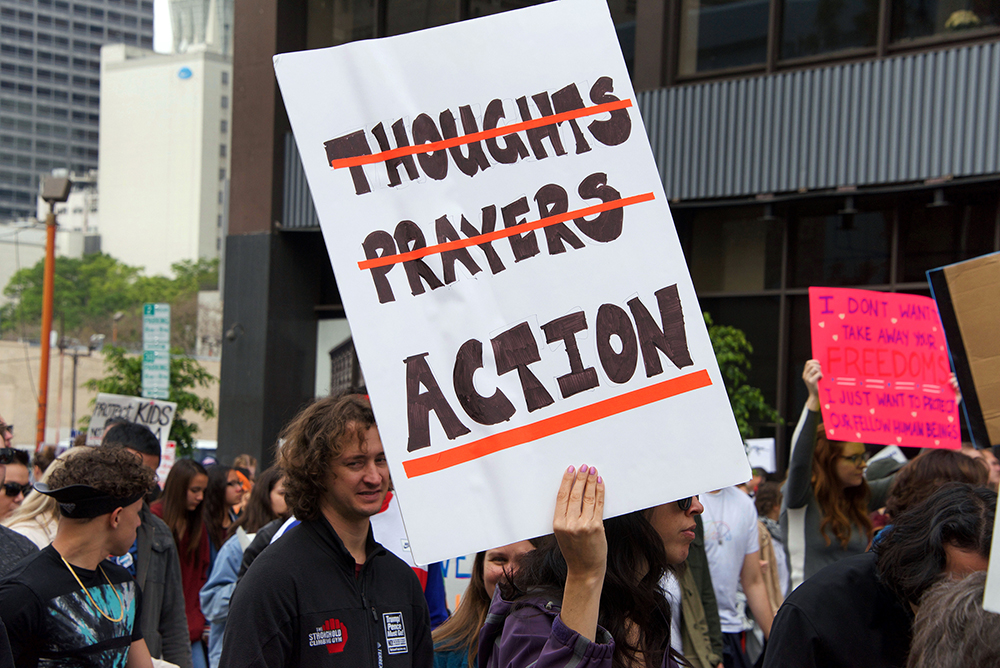I live a couple of counties away from where the mentally ill Robert Card, apparently hearing voices inside his head that sounded as if people were putting him down, shot up a bar and a bowling alley and forever changed the lives of too many of the good citizens of Maine.
The horror in what has been statistically the safest state in the nation competed for headlines with the exponentially larger agony of the brutal Hamas attack and Israel’s decimation of Gaza. The tragedies in Maine and Israel are cousins, however different in scale they appear. But are they in fact so different in scale? 48,000 Americans suffered gun-related deaths in 2021, the last year for which reliable statistics were available.
Our newly minted speaker of the House offered the usual contemptible dodge of thoughts and prayers, confirming the outrageous inability of our political system to address the gun violence epidemic. After the massacre, by contrast, one member of Congress, Lewiston-born Jared Golden, had the courage to change his mind toward favoring an assault rifle ban.
Ironically, there are very strict gun laws for civilians in the state of Israel. They must demonstrate good reason for gun ownership and obtain a permit, and people who are caught with an unlicensed gun receive strict sanctions, often a year in prison. The result has been far less gun deaths per capita there than here — at least until October 7th.
To get and to stay elected in the U.S., politicians have had to augment their campaign funds with the blood money of the NRA, tenaciously ignoring the clear wishes of the American people for sensible reforms like universal background checks. The U.S. Congress along with a majority on the Supreme Court stubbornly adheres to obsolete interpretations of an amendment that was written hundreds of years before the AR-15 perversely became “America’s gun.” Nick Kristof, in an excellent article The New York Times keeps republishing after each new mass shooting, makes a case for the “whys” of our appalling statistics (for one, the crystal-clear correlation between numbers of guns and gun deaths). Kristof also lays out the common-sense changes we could make that would save a whole bunch of lives. Liberals blame the conservative obsession with the Second Amendment while conservatives advocate beefing up mental health initiatives. But real solutions will not emerge from blaming and either/or polarities.
A similar political refusal to address root causes has come back to haunt Israeli politicians — and massacre the innocent by the thousands in both Israel and Gaza. Netanyahu maintains his power with a coalition that ignored the longing of great numbers of Israeli citizens for a peace that can only come by looking into the mirror of equivalent Palestinian longings. While a subtle anti-Semitism often holds Israel to a higher standard than other nations, its reputation will take a tremendous hit from its military’s vain attempt to stamp out an idea, or an attitude, by collective punishment. The catastrophic destructiveness of Israel’s reaction, far from eliminating the cynical and nihilistic Hamas, will ensure a further generation of young men who see no alternative to murder and martyrdom. Hamas is playing Netanyahu like a violin.
There are plenty of wise citizens of Israel who, in spite of their tears and rage, have not been swept away by the siren voices of violent revenge. New Yorker editor David Remnick’s recent on-site report cites a retired army general named Yair Golan, who told Remnick: “When you have a crisis, like Pearl Harbor or September 11th, it is a multidimensional crisis, a multidimensional failure. [Netanyahu] wanted quiet. So, while Hamas was relatively quiet, Netanyahu saw no need to have a vision for the larger Palestinian question. And since he needed the support of the settlers and the ultra-Orthodox, he appeased them. He created a situation in which, so long as the Palestinian Authority was weak, he could create the over-all perception that the best thing to do was to annex the West Bank. We weakened the very institution that we could have worked with, and strengthened Hamas.”
The cycle of violence is clearly systemic and cyclical, with mistakes, missed chances, and the inability of some to take “yes” for an answer. The righteous assertions of blame churned out by all sides becomes so much static, irrelevant to the copious flow of innocent blood.
In like fashion, the U.S. head-in-the-sand fetish of gun rights guarantees an equivalent flow of blood will continue here. Robert Card lost the capacity to see his victims as fully human. Netanyahu heeds a voice within that tells him that only more violence can save his nation. He has been unable to see Palestinians as fully human, just as Hamas refuses to see Jews as fully human.
The paralysis that continues this cycle of mutual dehumanization engulfing thousands of families and children in the Middle East may be different from the paralysis in the U.S. that failed to prevent yet another troubled man with a gun from mass murder and suicide. But the two tragedies are not only indistinguishable in their heartrending pain and loss.
In Maine and in Gaza, violence became the last best way to subdue the “other.” Robert Card didn’t get adequate help for his illness, and acquired a gun far too easily. It could have gone another way. Hamas and Netanyahu each chose mindless revenge. It could have gone another way.
Winslow Myers, syndicated by PeaceVoice, is the author of Living Beyond War: A Citizen’s Guide and serves on the advisory board of the War Prevention Initiative.

